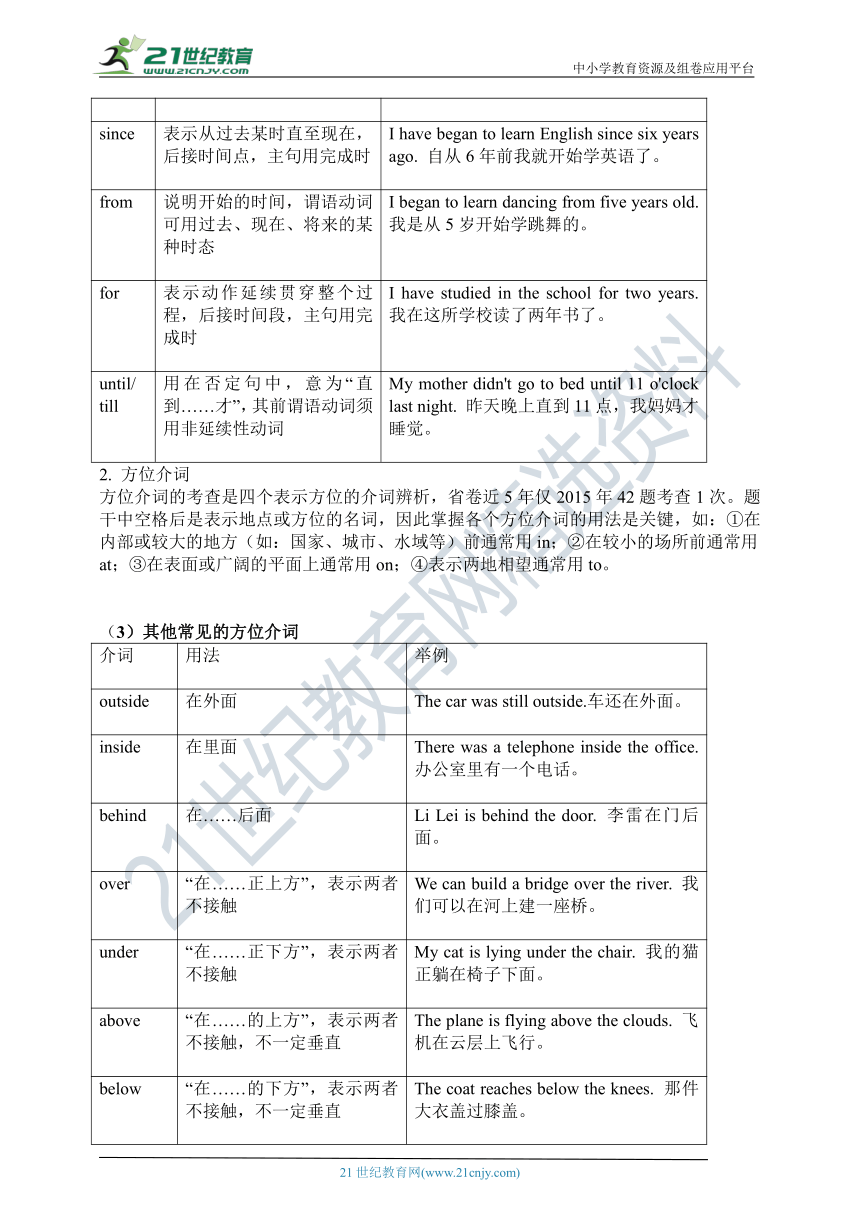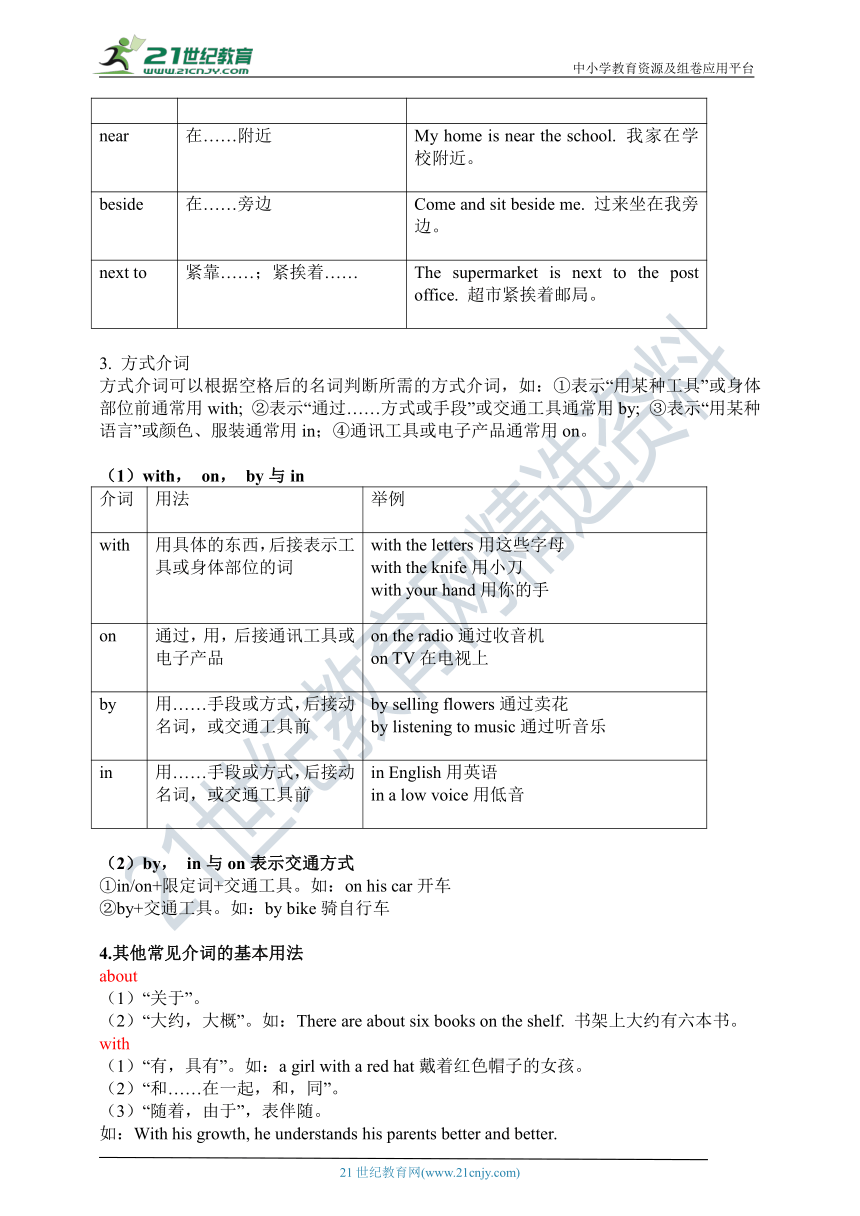2022年中考英语语法专项五 介词讲义
图片预览



文档简介
中小学教育资源及组卷应用平台
专项五 介词
时间介词
时间介词的考查通常是四个表示时间的介词辨析,因此考生需掌握并区分各个时间介词的用法,如:①时刻前通常用at;②星期、日期或具体的某一天前通常用on;③月份、年份或泛指的上下午通常用in。
(1)on, in, at, by与to
介词 用法 举例
on 用于具体某一天或某一天的早上、下午、晚上前,星期或节日前 on August 1st last year在去年的八月一号 on the evening of June 22nd在六月二十二号晚上 on the second Sunday在第二个星期天 on Women’s Day在妇女节
in 表一段时间,用于年、月、世纪、四季或泛指一天的上午、下午、晚上等前 in May在五月 in the twenty-first century在21世纪 in summer在夏天 in the morning在早上
at 用于具体的时间点前或黎明、正午、午夜前 at 6:00在六点 at noon在正午at night在晚上
by 表示最迟在某一时刻或某一日期之前 by next Monday 下周一之前 by this afternoon今天下午之前 by now到现在
to 表示时间范围,通常与from连用,意为“从……” from 5:00 to 9:00从5点到9点from Monday to Friday从周一到周五from 1991 to 2018从1991年到2018年
(2)其他常见的时间介词
介词 用法 举例
after 与将来时连用,表示“……之后”,后接时间点 He’ll arrive at the airport after four o’clock. 他将在四点钟后到机场。
与过去时连用,表示“……之后”,后接时间段 I received the letter after two days. 我两天后收到了这封信。
before 表示“在……之前” Wash your hands before dinner. 饭前要洗手。
since 表示从过去某时直至现在,后接时间点,主句用完成时 I have began to learn English since six years ago. 自从6年前我就开始学英语了。
from 说明开始的时间,谓语动词可用过去、现在、将来的某种时态 I began to learn dancing from five years old. 我是从5岁开始学跳舞的。
for 表示动作延续贯穿整个过程,后接时间段,主句用完成时 I have studied in the school for two years. 我在这所学校读了两年书了。
until/till 用在否定句中,意为“直到……才”,其前谓语动词须用非延续性动词 My mother didn't go to bed until 11 o'clock last night. 昨天晚上直到11点,我妈妈才睡觉。
2. 方位介词
方位介词的考查是四个表示方位的介词辨析,省卷近5年仅2015年42题考查1次。题干中空格后是表示地点或方位的名词,因此掌握各个方位介词的用法是关键,如:①在内部或较大的地方(如:国家、城市、水域等)前通常用in;②在较小的场所前通常用at;③在表面或广阔的平面上通常用on;④表示两地相望通常用to。
(3)其他常见的方位介词
介词 用法 举例
outside 在外面 The car was still outside.车还在外面。
inside 在里面 There was a telephone inside the office.办公室里有一个电话。
behind 在……后面 Li Lei is behind the door. 李雷在门后面。
over “在……正上方”,表示两者不接触 We can build a bridge over the river. 我们可以在河上建一座桥。
under “在……正下方”,表示两者不接触 My cat is lying under the chair. 我的猫正躺在椅子下面。
above “在……的上方”,表示两者不接触,不一定垂直 The plane is flying above the clouds. 飞机在云层上飞行。
below “在……的下方”,表示两者不接触,不一定垂直 The coat reaches below the knees. 那件大衣盖过膝盖。
near 在……附近 My home is near the school. 我家在学校附近。
beside 在……旁边 Come and sit beside me. 过来坐在我旁边。
next to 紧靠……;紧挨着…… The supermarket is next to the post office. 超市紧挨着邮局。
3. 方式介词
方式介词可以根据空格后的名词判断所需的方式介词,如:①表示“用某种工具”或身体部位前通常用with; ②表示“通过……方式或手段”或交通工具通常用by; ③表示“用某种语言”或颜色、服装通常用in;④通讯工具或电子产品通常用on。
(1)with, on, by与in
介词 用法 举例
with 用具体的东西,后接表示工具或身体部位的词 with the letters用这些字母with the knife用小刀with your hand用你的手
on 通过,用,后接通讯工具或电子产品 on the radio通过收音机on TV在电视上
by 用……手段或方式,后接动名词,或交通工具前 by selling flowers通过卖花by listening to music通过听音乐
in 用……手段或方式,后接动名词,或交通工具前 in English用英语in a low voice用低音
(2)by, in与on表示交通方式
①in/on+限定词+交通工具。如:on his car开车
②by+交通工具。如:by bike骑自行车
4.其他常见介词的基本用法
about
(1)“关于”。
(2)“大约,大概”。如:There are about six books on the shelf. 书架上大约有六本书。
with
(1)“有,具有”。如:a girl with a red hat戴着红色帽子的女孩。
(2)“和……在一起,和,同”。
(3)“随着,由于”,表伴随。
如:With his growth, he understands his parents better and better.
随着他的成长,他越来越理解他的父母。
without
“没有,缺乏”,表示否定。
against
(1)“反对,违背”,其反义词为for。
(2)“对抗,和……竞争”。
(3)“紧靠”。如:Put the piano there, against the door.把钢琴放在那里,靠着门。
for
(1)为了……,对于……。表示目的、对象。
如:What did you go there for 你为什么去那里?
(2)赞成。与against相反,常与系动词be连用。
如:I think you’ll be for my opinion. 我认为你会赞成我的观点。
around
“四处,在……周围”。
as
(1)“作为,以……身份”。(2)“像,如同,跟……一样”。
between
(1)“(空间上)在……中间”,指在两个人或两个事物之间,常用于between...and...。如:She sat between her father and mother. 她坐在了父亲和母亲之间。
(2)“(时间上)在……中间”。
among
(1)“在……中,周围是”。
(2)“在……其中;……之一”,强调在三者或三者以上的人或事物之间。
如:He is the bravest among the three boys. 三个男孩中他是最勇敢的。
from
(1)“(表示来源)来自”。
(2)“(表示判断的原因)根据,从……来看”。
to
“向,朝,对着(某方向或某处)”。
in
(1)“在(范围或空间内)的某一点”。如:I read the news in the newspaper.我在报纸上读到了这条新闻。
(2)“进入”。
(3)“穿着,戴着”。
into
(1)“到……里面;进入”。
(2)“朝,向,对着”。如:Speak clearly into the microphone.对着麦克风清楚地讲话。
like
(1)“相似,类似,像”。如:He’s very like his father.他很像他的父亲。
(2)“例如,譬如”。
如:He thinks the figure should be more like 10 million.他认为要是1000万就差不多了。
(3)“像……一样”。
of
(1)“属于(某人);关于(某人)”,表示所属关系。
(2)“用于表示计量、时间或年龄”。如:2 kilos of potatoes两公斤马铃薯。
through
(1)“从……一端至另一端;穿过(强调从物体内部过)”。
(2)“通过(障碍、阶段或考试)”。如:He got through all the exams.他通过了所有的考试。
(3)“以,凭借”。
命题点2 介词短语及固定搭配
in短语
in trouble处于困境中 in peace和平 in pain处于疼痛地 in public在公共场所in danger处于危险之中 in fact事实上;实际上in the future在将来in a hurry匆忙;很快地in half分成两半 in time及时 in total总共in turn依次地;轮流地 in the end最后;终于in all总之 in order按顺序in one’s opinion依某人看
on短语
on time准时on duty值日;值班on foot走路;步行 on sale廉价出售;出售on show展出;在上演(放映)on vacation 度假 on board在船上on one's way to在某人去……的路上
at 短语
at first首先 at last最后at least至少 at birth出生时at times有时;偶尔 at present目前;现在 at the beginning of 在……开始时at the same time与此同时
by 短语
by chance偶然by hand用手做by the time直到……时候;到……之前 by the way顺便说/问一下by mistake错误地by accident偶然地 by air(bus, train, ship)乘飞机(公交车、火车、轮船)
of 短语
instead of代替;而不是the number of……的数量kind of稍微;有点儿 plenty of很多的;足够的lots of大量;许多 a lot of 许多;大量 a kind of 一种;一类 all kinds of 各种各样的ahead of 在……之前 because of 因为;由于hundreds of 成百上千;许多;大量millions of数以百万的 in the face of 面对(问题、困难等)in front of 在……前面(表示在外部的前面)in the front of 在……前面(表示在内部的前面)the symbol of……的象征
to 短语
thanks to 幸亏;由于;因为to one’s surprise令某人惊讶/ 吃惊的是……on the way to在去……的路上 in order to为了according to 根据;按照;据……所说;视……而定close to 接近 next to紧靠……的旁边;贴近;最接近to be honest(作插入语)老实说;说实在的to start with首先
介词与形容词/过去分词搭配
be different from与……不同be strict with sb.对某人严格要求be born in出生于……be interested in对……感兴趣be good at擅长…… be surprised at对……感到惊奇/诧异be angry with sb.对某人生气be pleased with sb.对某人感到满意be satisfied with sth.对某事感到满意 be busy with 忙于be made of 由……制成be tired of 讨厌……/厌倦……be proud of 为……而自豪/骄傲be full of/be filled with 充满……be popular with 受……欢迎
介词与动词/名词的搭配
speak to 与……讲话happen to )偶然发生)play a role in 在……中扮演角色 welcome to 欢迎put…into 把……放进……talk with 与……交谈 fill…with 用……填满prefer to… 更喜欢……
21世纪教育网 www.21cnjy.com 精品试卷·第 2 页 (共 2 页)
HYPERLINK "http://21世纪教育网(www.21cnjy.com)
" 21世纪教育网(www.21cnjy.com)
专项五 介词
时间介词
时间介词的考查通常是四个表示时间的介词辨析,因此考生需掌握并区分各个时间介词的用法,如:①时刻前通常用at;②星期、日期或具体的某一天前通常用on;③月份、年份或泛指的上下午通常用in。
(1)on, in, at, by与to
介词 用法 举例
on 用于具体某一天或某一天的早上、下午、晚上前,星期或节日前 on August 1st last year在去年的八月一号 on the evening of June 22nd在六月二十二号晚上 on the second Sunday在第二个星期天 on Women’s Day在妇女节
in 表一段时间,用于年、月、世纪、四季或泛指一天的上午、下午、晚上等前 in May在五月 in the twenty-first century在21世纪 in summer在夏天 in the morning在早上
at 用于具体的时间点前或黎明、正午、午夜前 at 6:00在六点 at noon在正午at night在晚上
by 表示最迟在某一时刻或某一日期之前 by next Monday 下周一之前 by this afternoon今天下午之前 by now到现在
to 表示时间范围,通常与from连用,意为“从……” from 5:00 to 9:00从5点到9点from Monday to Friday从周一到周五from 1991 to 2018从1991年到2018年
(2)其他常见的时间介词
介词 用法 举例
after 与将来时连用,表示“……之后”,后接时间点 He’ll arrive at the airport after four o’clock. 他将在四点钟后到机场。
与过去时连用,表示“……之后”,后接时间段 I received the letter after two days. 我两天后收到了这封信。
before 表示“在……之前” Wash your hands before dinner. 饭前要洗手。
since 表示从过去某时直至现在,后接时间点,主句用完成时 I have began to learn English since six years ago. 自从6年前我就开始学英语了。
from 说明开始的时间,谓语动词可用过去、现在、将来的某种时态 I began to learn dancing from five years old. 我是从5岁开始学跳舞的。
for 表示动作延续贯穿整个过程,后接时间段,主句用完成时 I have studied in the school for two years. 我在这所学校读了两年书了。
until/till 用在否定句中,意为“直到……才”,其前谓语动词须用非延续性动词 My mother didn't go to bed until 11 o'clock last night. 昨天晚上直到11点,我妈妈才睡觉。
2. 方位介词
方位介词的考查是四个表示方位的介词辨析,省卷近5年仅2015年42题考查1次。题干中空格后是表示地点或方位的名词,因此掌握各个方位介词的用法是关键,如:①在内部或较大的地方(如:国家、城市、水域等)前通常用in;②在较小的场所前通常用at;③在表面或广阔的平面上通常用on;④表示两地相望通常用to。
(3)其他常见的方位介词
介词 用法 举例
outside 在外面 The car was still outside.车还在外面。
inside 在里面 There was a telephone inside the office.办公室里有一个电话。
behind 在……后面 Li Lei is behind the door. 李雷在门后面。
over “在……正上方”,表示两者不接触 We can build a bridge over the river. 我们可以在河上建一座桥。
under “在……正下方”,表示两者不接触 My cat is lying under the chair. 我的猫正躺在椅子下面。
above “在……的上方”,表示两者不接触,不一定垂直 The plane is flying above the clouds. 飞机在云层上飞行。
below “在……的下方”,表示两者不接触,不一定垂直 The coat reaches below the knees. 那件大衣盖过膝盖。
near 在……附近 My home is near the school. 我家在学校附近。
beside 在……旁边 Come and sit beside me. 过来坐在我旁边。
next to 紧靠……;紧挨着…… The supermarket is next to the post office. 超市紧挨着邮局。
3. 方式介词
方式介词可以根据空格后的名词判断所需的方式介词,如:①表示“用某种工具”或身体部位前通常用with; ②表示“通过……方式或手段”或交通工具通常用by; ③表示“用某种语言”或颜色、服装通常用in;④通讯工具或电子产品通常用on。
(1)with, on, by与in
介词 用法 举例
with 用具体的东西,后接表示工具或身体部位的词 with the letters用这些字母with the knife用小刀with your hand用你的手
on 通过,用,后接通讯工具或电子产品 on the radio通过收音机on TV在电视上
by 用……手段或方式,后接动名词,或交通工具前 by selling flowers通过卖花by listening to music通过听音乐
in 用……手段或方式,后接动名词,或交通工具前 in English用英语in a low voice用低音
(2)by, in与on表示交通方式
①in/on+限定词+交通工具。如:on his car开车
②by+交通工具。如:by bike骑自行车
4.其他常见介词的基本用法
about
(1)“关于”。
(2)“大约,大概”。如:There are about six books on the shelf. 书架上大约有六本书。
with
(1)“有,具有”。如:a girl with a red hat戴着红色帽子的女孩。
(2)“和……在一起,和,同”。
(3)“随着,由于”,表伴随。
如:With his growth, he understands his parents better and better.
随着他的成长,他越来越理解他的父母。
without
“没有,缺乏”,表示否定。
against
(1)“反对,违背”,其反义词为for。
(2)“对抗,和……竞争”。
(3)“紧靠”。如:Put the piano there, against the door.把钢琴放在那里,靠着门。
for
(1)为了……,对于……。表示目的、对象。
如:What did you go there for 你为什么去那里?
(2)赞成。与against相反,常与系动词be连用。
如:I think you’ll be for my opinion. 我认为你会赞成我的观点。
around
“四处,在……周围”。
as
(1)“作为,以……身份”。(2)“像,如同,跟……一样”。
between
(1)“(空间上)在……中间”,指在两个人或两个事物之间,常用于between...and...。如:She sat between her father and mother. 她坐在了父亲和母亲之间。
(2)“(时间上)在……中间”。
among
(1)“在……中,周围是”。
(2)“在……其中;……之一”,强调在三者或三者以上的人或事物之间。
如:He is the bravest among the three boys. 三个男孩中他是最勇敢的。
from
(1)“(表示来源)来自”。
(2)“(表示判断的原因)根据,从……来看”。
to
“向,朝,对着(某方向或某处)”。
in
(1)“在(范围或空间内)的某一点”。如:I read the news in the newspaper.我在报纸上读到了这条新闻。
(2)“进入”。
(3)“穿着,戴着”。
into
(1)“到……里面;进入”。
(2)“朝,向,对着”。如:Speak clearly into the microphone.对着麦克风清楚地讲话。
like
(1)“相似,类似,像”。如:He’s very like his father.他很像他的父亲。
(2)“例如,譬如”。
如:He thinks the figure should be more like 10 million.他认为要是1000万就差不多了。
(3)“像……一样”。
of
(1)“属于(某人);关于(某人)”,表示所属关系。
(2)“用于表示计量、时间或年龄”。如:2 kilos of potatoes两公斤马铃薯。
through
(1)“从……一端至另一端;穿过(强调从物体内部过)”。
(2)“通过(障碍、阶段或考试)”。如:He got through all the exams.他通过了所有的考试。
(3)“以,凭借”。
命题点2 介词短语及固定搭配
in短语
in trouble处于困境中 in peace和平 in pain处于疼痛地 in public在公共场所in danger处于危险之中 in fact事实上;实际上in the future在将来in a hurry匆忙;很快地in half分成两半 in time及时 in total总共in turn依次地;轮流地 in the end最后;终于in all总之 in order按顺序in one’s opinion依某人看
on短语
on time准时on duty值日;值班on foot走路;步行 on sale廉价出售;出售on show展出;在上演(放映)on vacation 度假 on board在船上on one's way to在某人去……的路上
at 短语
at first首先 at last最后at least至少 at birth出生时at times有时;偶尔 at present目前;现在 at the beginning of 在……开始时at the same time与此同时
by 短语
by chance偶然by hand用手做by the time直到……时候;到……之前 by the way顺便说/问一下by mistake错误地by accident偶然地 by air(bus, train, ship)乘飞机(公交车、火车、轮船)
of 短语
instead of代替;而不是the number of……的数量kind of稍微;有点儿 plenty of很多的;足够的lots of大量;许多 a lot of 许多;大量 a kind of 一种;一类 all kinds of 各种各样的ahead of 在……之前 because of 因为;由于hundreds of 成百上千;许多;大量millions of数以百万的 in the face of 面对(问题、困难等)in front of 在……前面(表示在外部的前面)in the front of 在……前面(表示在内部的前面)the symbol of……的象征
to 短语
thanks to 幸亏;由于;因为to one’s surprise令某人惊讶/ 吃惊的是……on the way to在去……的路上 in order to为了according to 根据;按照;据……所说;视……而定close to 接近 next to紧靠……的旁边;贴近;最接近to be honest(作插入语)老实说;说实在的to start with首先
介词与形容词/过去分词搭配
be different from与……不同be strict with sb.对某人严格要求be born in出生于……be interested in对……感兴趣be good at擅长…… be surprised at对……感到惊奇/诧异be angry with sb.对某人生气be pleased with sb.对某人感到满意be satisfied with sth.对某事感到满意 be busy with 忙于be made of 由……制成be tired of 讨厌……/厌倦……be proud of 为……而自豪/骄傲be full of/be filled with 充满……be popular with 受……欢迎
介词与动词/名词的搭配
speak to 与……讲话happen to )偶然发生)play a role in 在……中扮演角色 welcome to 欢迎put…into 把……放进……talk with 与……交谈 fill…with 用……填满prefer to… 更喜欢……
21世纪教育网 www.21cnjy.com 精品试卷·第 2 页 (共 2 页)
HYPERLINK "http://21世纪教育网(www.21cnjy.com)
" 21世纪教育网(www.21cnjy.com)
同课章节目录
- 词法
- 名词
- 动词和动词短语
- 动词语态
- 动词时态
- 助动词和情态动词
- 非谓语动词
- 冠词
- 代词
- 数词和量词
- 形容词副词及其比较等级
- 介词和介词短语
- 连词和感叹词
- 构词法
- 相似、相近词比较
- 句法
- 陈述句
- 一般疑问句和否定疑问句
- 特殊疑问句及选择疑问句
- 反意疑问句
- 存在句(There be句型)
- 宾语从句
- 定语从句
- 状语从句
- 主谓一致问题
- 简单句
- 并列句
- 复合句
- 主谓一致
- 主、表语从句
- 名词性从句
- 直接引语和间接引语
- 虚拟语气
- 感叹句
- 强调句
- 倒装句
- 祈使句
- 句子的成分
- 句子的分类
- 题型专区
- 单项选择部分
- 易错题
- 完形填空
- 阅读理解
- 词汇练习
- 听说训练
- 句型转换
- 补全对话
- 短文改错
- 翻译
- 书面表达
- 任务型阅读
- 语法填空
- 其他资料
